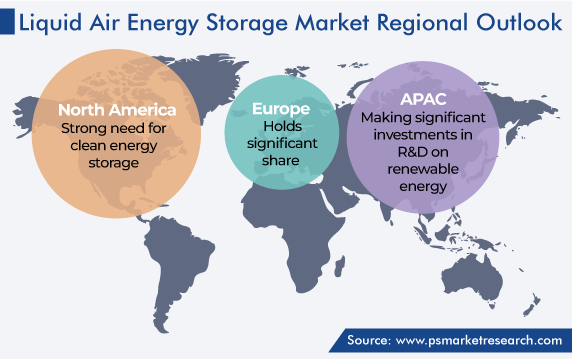Report Code: 12829 | Available Format: PDF | Pages: 246
Liquid Air Energy Storage Market Size and Share Analysis by Capacity (5-15 MW, 16-50 MW, 51-100 MW, More than 100 MW), Application (Commercial, Industrial, Residential) - Global Industry Growth Forecast to 2030
- Report Code: 12829
- Available Format: PDF
- Pages: 246
- Report Description
- Table of Contents
- Market Segmentation
- Request Free Sample
Liquid Air Energy Storage Market Size & Share
The liquid air energy storage market is set to generate an estimated USD 1,472.9 million in 2023 and grow at a CAGR of 18.8% during 2024–2030, to reach USD 4,887.6 million by 2030.
This can be ascribed to the rising demand for power due to industrialization and globalization. The potential applications of this technology include peaking power, load following or grid support services, and emergency backup power. These systems also have the potential to offer supplementary services, such as voltage control and frequency regulation. Additionally, it is a flexible, long-duration energy storage (LDES) technology. It uses air for generating electricity; the air is stored as a liquid by cooling it down and, later, turned back to the gaseous form to propel turbines.

When compared to the existing storage technologies, LAES has many advantages, including a high energy density and easy setup, and it also helps in load leveling and peak shaving. This helps in maximizing the efficiency of power systems, minimizing peak-time load on the grid, controlling the grid frequency, and enabling the effective utilization of power plants.
Moreover, LAES systems offered by most market players have a long life, of up to 35 years. Additionally, systems made by MAN Energy Solutions are capable of producing more than 45,000 tons of liquefied air every day. Overall, the power range of LAES systems is over 100 MW. There are single and multistage designs to achieve the balance between cost and efficiency. Its advantages are a long life, no deterioration, high efficiency, and availability in medium-to-large sizes for compressors and air expanders.
Additionally, emergency backup is a key application, where LAES allows customers to avoid downtimes in the case of a major grid outage. Especially for the industrial sector, which uses lot of energy worldwide, demand-side management offers the potential for significant energy cost-savings. It is a strategy employed by utilities to adjust customers’ energy usage through a series of initiatives, in order to achieve load-shape goals. These interventions could be valley filling, load shifting, peak trimming, and strategic conservation.
Global Decarbonization Targets Are Key Drivers
The electricity & heat sector is the highest emitter of greenhouse gases worldwide, releasing approximately 14.65 Gt in 2022. Governments of many countries have set targets to achieve net-zero till 2050, for which emission reduction mandates have been implemented on various industries, such as electricity & heat, manufacturing, and transportation.
Additionally, with the increasing energy demand, the power & energy sector is continuously involved in R&D and investments. The aim behind these initiatives is to fulfill the demand and improve the overall operations, to reduce emissions. This goal could be achieved with the adoption of the LAES technology as it stores a high volume of air in small areas, without any emissions. Further, this sector is focusing on innovations in the power grid, with popular topics for research being renewable grids, smart grids, and overall grid flexibility.
These storage systems have now surfaced as a pragmatic solution in this regard. Grid-scale applications can benefit from its LDES capability as it helps in voltage fluctuation, frequency regulation, grid congestion, and other aspects. LDES, ranging from several hours to days or weeks, is possible with liquid air energy storage systems.
Integration of LAES into Renewable Energy for Demand–Supply Balance
Carbon emissions will be decreased by using renewable energy sources, such as solar and wind. But, since energy generation with these sources is intermittent, an irregular energy output could lead to a number of problems for the electrical system.
Both the day/night cycle and weather patterns have an impact on renewable power generation. As a result, storing electricity whenever possible could facilitate the incorporation of the fluctuating renewable energy sources (RESs) into the grid. Additionally, some studies show that the integration of intermittent RESs, such as solar thermal, geothermal, wind, and solar PV, for charging and discharging LAES can completely transform this system into a renewable one, as fossil fuel-based energy would be eliminated completely.
Energy from renewable sources is fed into an air liquefaction unit during off-peak hours. When electricity is required, the liquid air can be piped, heated, and expanded inside turbines to produce power. Since LAES has a far higher energy density than PHS and CAES, it does not require large storage capacities. Furthermore, it is one of the few technologies that can provide large-scale storage without being affected by location. Additionally, with this approach, energy ‘co-recovery’ is possible, since the cold generated by liquid cryogen evaporation is not lost. The cold can be ‘recycled’ for a variety of purposes, especially in the food processing and sustainable refrigeration industries.
In June 2023, the European Commission and COP28 announced a global target to triple the installed capacity of renewable energy sources to 11 TW by 2030 and double the global rate of energy efficiency improvements for this decade compared to the last one. With the rise in production through these sources, more LAES systems will be integrated due to their ability to increase the charge and discharge efficiency and decrease power costs.
For instance, in an effort to demonstrate the viability and financial benefits of combining offshore wind turbines with long-duration storage, two companies, Highview Power and Orsted, started working together in 2023. The project involves fusing Orsted's wind technology with Highview Power's LAES systems. Throughout the year, both sides conducted technical studies and economic evaluations to determine whether liquid air energy storage could aid in lowering wind curtailment to reduce variability, boosting output, and facilitating the transition to a more-adaptable, durable zero-carbon grid.
Another startup, named Phelas, based in Germany, is working on this concept, having developed LAES systems for solar and wind installations. The group has been developing Aurora, a novel, large-scale electrical storage technology, which is moveable, affordable, and mass-manufactured. It has also created a containerized storage system, which allows the entire LAES setup to be mobile and adaptable.
| Report Attribute | Details |
Market Size in 2023 |
USD 1,472.9 Million |
Market Size in 2024 |
USD 1,739.4 Million |
Revenue Forecast in 2030 |
USD 4,887.6 Million |
Growth Rate |
18.8% CAGR |
Historical Years |
2017-2023 |
Forecast Years |
2024-2030 |
Report Scope |
Market Trends, Drivers, and Restraints; Revenue Estimation and Forecast; Segmentation Analysis; Impact of COVID-19; Companies’ Strategic Developments; Market Share Analysis of Key Players; Company Profiling |
Segments Covered |
By Capacity, By Application, By Region |
Explore more about this report - Request free sample
North America Is Largest Market
Largest markets for liquid air energy storage systems is North America. The U.S. has invested in renewable energy for a considerable time and set high goals for the future. For instance, as per reports, approximately 90 energy storage projects have been commissioned in California in one of the largest commissioned energy storage programs. Firms in the state are pairing solar resources to increase the overall system reliability. Further, the U.S. and Canada markets are being driven by the strong need for clean energy storage and the collaborations among companies to achieve this vision.
APAC is expected to witness significant growth in the market, at a CAGR of 19.2%, till 2030, as a result of the region's fast economic expansion and industrialization. The LAES system works with any gas; therefore, it is used in many industries, such as oil & gas and power & energy. Some key applications of this technology in the region are backup power, carbon capture, and industrial process cooling (as liquified air can absorb significant heat). Furthermore, Asia-Pacific nations are making significant investments in R&D on renewable energy, which is projected to accelerate the market expansion even faster. For instance, India’s storage capacity required by 2030 is 160 GWh, and the renewable energy sector itself needs 61% of this to fulfill the energy decarbonization targets set by the government.

Top Players in Liquid Air Energy Storage Market
- Highview Enterprises Ltd
- MAN Energy Solutions SE
- General Electric Company
- Linde plc
- Messer SE & Co. KGaA
- Mitsubishi Hitachi Power System
- Siem
Market Size Breakdown by Segment
The study uncovers the biggest trends and opportunities in the liquid air energy storage market, along with offering segmentation analysis at the granular level for the period 2017 to 2030.
Based on Capacity
- 5–15 MW
- 16–50 MW
- 51–100 MW
- More than 100 MW
Based on Application
- Commercial
- Industrial
- Residential
Geographical Analysis
- North America
- U.S.
- Canada
- Europe
- Germany
- U.K.
- France
- Italy
- Spain
- Asia-Pacific
- Japan
- China
- India
- South Korea
- Australia
- Latin America
- Brazil
- Mexico
- Middle East and Africa
- Saudi Arabia
- South Africa
- U.A.E.
The market for liquid air energy storage solutions values USD 1,472.9 million in 2023.
By 2030, the liquid air energy storage industry will reach USD 4,887.6 million.
The market for liquid air energy storage solutions is growing with the rampant urbanization and industrialization.
The integration of LAES systems with renewable power installations is trending in the liquid air energy storage industry.
The government regulations for decarbonization are the biggest drivers for the market for liquid air energy storage solutions.
North America dominates the liquid air energy storage industry.
Europe and APAC hold significant shares in the market for liquid air energy storage solutions.
Want a report tailored exactly to your business strategy?
Request CustomizationWant an insight-rich discussion with the report author?
Speak to AnalystOur dedication to providing the most-accurate market information has earned us verification by Dun & Bradstreet (D&B). We strive for quality checking of the highest level to enable data-driven decision making for you
Our insights into the minutest levels of the markets, including the latest trends and competitive landscape, give you all the answers you need to take your business to new heights
With 24/7 research support, we ensure that the wheels of your business never stop turning. Don’t let time stand in your way. Get all your queries answered with a simple phone call or email, as and when required
We take a cautious approach to protecting your personal and confidential information. Trust is the strongest bond that connects us and our clients, and trust we build by complying with all international and domestic data protection and privacy laws